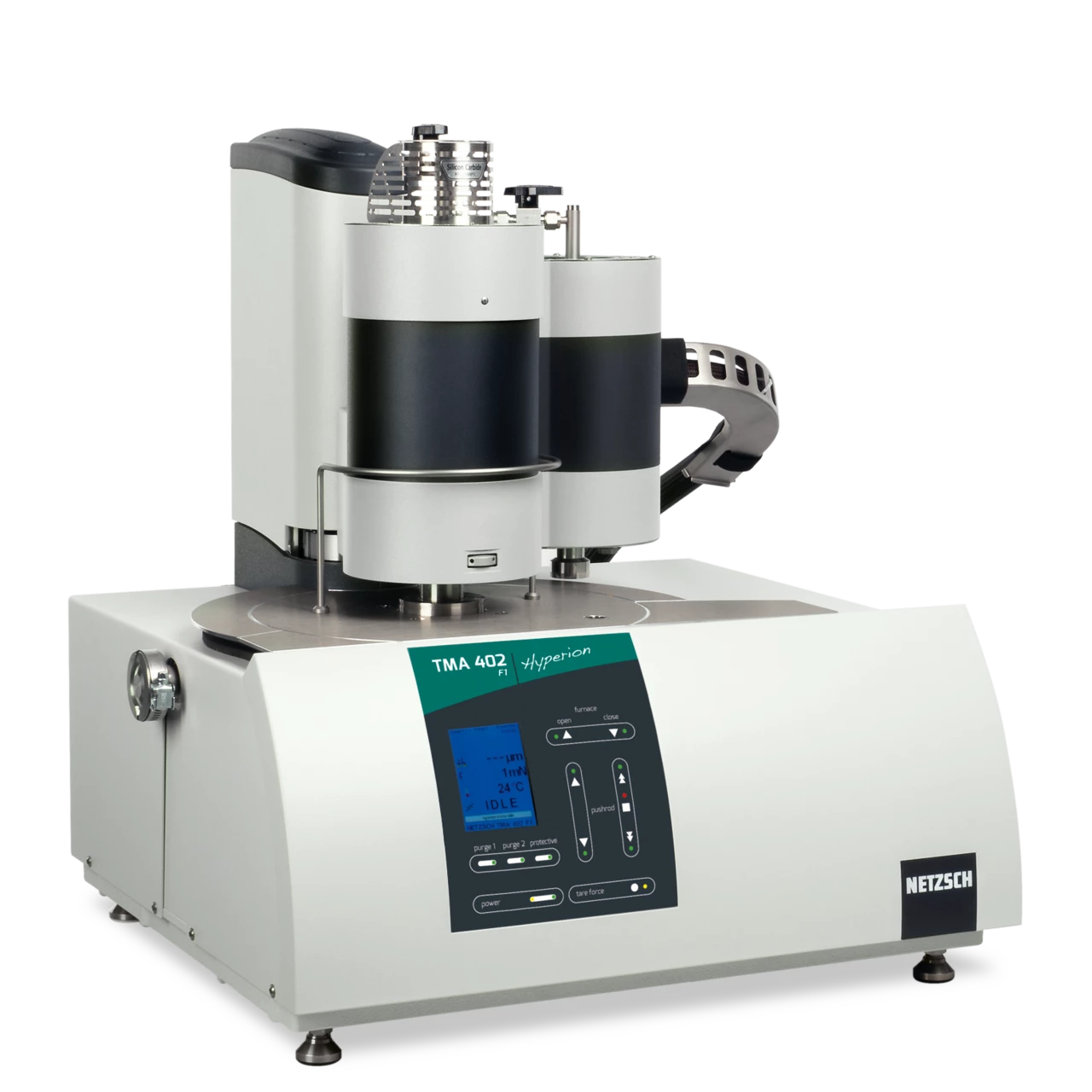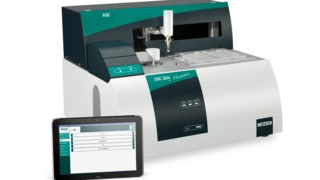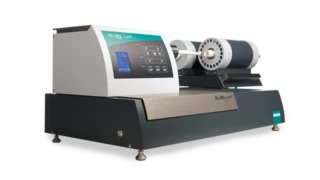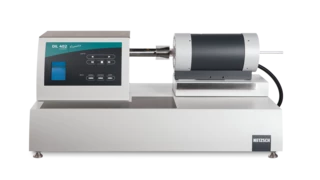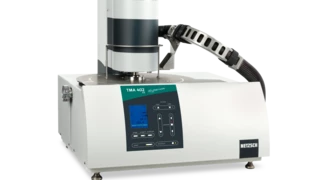The heart of the TMA 402 Hyperion® is a highly precise inductive displacement transducer (LVDT).
This technology has stood the test of time; it is also used for dilatometers and allows measurement of even the smallest of length changes, into the nanometer range (digital resolution of 0.125 nm).
Simultaneous measurement of force and displacement signal
The force operating on the sample is generated electromagnetically in the TMA 402 Hyperion®. This guarantees a quick response time for experiments with a changing load, e.g. tests on CreepCreep describes a time and temperature dependent plastic deformation under a constant force. When a constant force is applied to a rubber compound, the initial deformation obtained due to the application of the force is not fixed. The deformation will increase with time.creep behavior. A highly sensitive force sensor (digital resolution < 0.01 mN) continuously measures the force exerted via the push rod and readjusts it automatically. This sets the TMA 402 Hyperion® apart from other instruments, which use only preset values.
Benefits for you
- Modular Concept with interchangeable furnaces (compatible with other NETZSCH instruments) for easy and cost-effective expansion and retrofitting
- Gas flows with up to 4 MFCs, controllable via software with programmable atmosphere change for the analysis of e.g. OxidationOxidation can describe different processes in the context of thermal analysis.oxidation behavior without manual valve operation
- Digitally programmable force or displacement control up to 4 N (only for F1 , 3 N for F3 ) with linear or stepwise force alteration and continuous force modulation for determining visco-elastic properties like RelaxationWhen a constant strain is applied to a rubber compound, the force necessary to maintain that strain is not constant but decreases with time; this behavior is known as stress relaxation. The process responsible for stress relaxation can be physical or chemical, and under normal conditions, both will occur at the same time. relaxation, CreepCreep describes a time and temperature dependent plastic deformation under a constant force. When a constant force is applied to a rubber compound, the initial deformation obtained due to the application of the force is not fixed. The deformation will increase with time.creep and StressStress is defined as a level of force applied on a sample with a well-defined cross section. (Stress = force/area). Samples having a circular or rectangular cross section can be compressed or stretched. Elastic materials like rubber can be stretched up to 5 to 10 times their original length.stress/StrainStrain describes a deformation of a material, which is loaded mechanically by an external force or stress. Rubber compounds show creep properties, if a static load is applied.strain
- Various accessories for an expanded application range, e.g., for measuring powders, liquids, pastes or metals
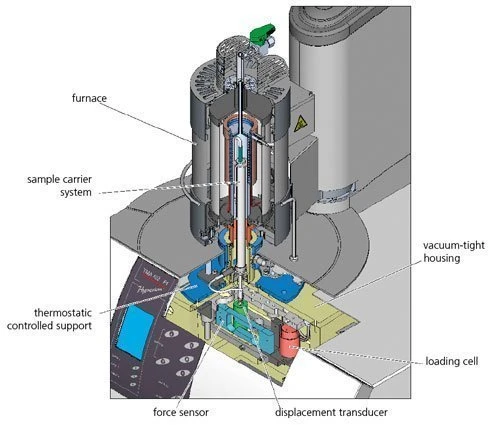
Determination of viscoelastic properties like Relaxation, Creep and Stress/Strain
The TMA 402 F3 /F1 Hyperion® now offers not only to keep the force constant and to measure the length change, but also to change the displacement and measure the corresponding force. One example where this is used is the StressStress is defined as a level of force applied on a sample with a well-defined cross section. (Stress = force/area). Samples having a circular or rectangular cross section can be compressed or stretched. Elastic materials like rubber can be stretched up to 5 to 10 times their original length.stress-RelaxationWhen a constant strain is applied to a rubber compound, the force necessary to maintain that strain is not constant but decreases with time; this behavior is known as stress relaxation. The process responsible for stress relaxation can be physical or chemical, and under normal conditions, both will occur at the same time. relaxation test. This test stretches a sample by a specific amount at a defined temperature. During the test, the deformation is kept constant and the progression of the force is recorded. This force continuously decreases as a result of material RelaxationWhen a constant strain is applied to a rubber compound, the force necessary to maintain that strain is not constant but decreases with time; this behavior is known as stress relaxation. The process responsible for stress relaxation can be physical or chemical, and under normal conditions, both will occur at the same time. relaxation. The StressStress is defined as a level of force applied on a sample with a well-defined cross section. (Stress = force/area). Samples having a circular or rectangular cross section can be compressed or stretched. Elastic materials like rubber can be stretched up to 5 to 10 times their original length.stress-RelaxationWhen a constant strain is applied to a rubber compound, the force necessary to maintain that strain is not constant but decreases with time; this behavior is known as stress relaxation. The process responsible for stress relaxation can be physical or chemical, and under normal conditions, both will occur at the same time. relaxation strength is ultimately defined by the residual StressStress is defined as a level of force applied on a sample with a well-defined cross section. (Stress = force/area). Samples having a circular or rectangular cross section can be compressed or stretched. Elastic materials like rubber can be stretched up to 5 to 10 times their original length.stress measured after a defined exposure period. The data can be depicted graphically in a StressStress is defined as a level of force applied on a sample with a well-defined cross section. (Stress = force/area). Samples having a circular or rectangular cross section can be compressed or stretched. Elastic materials like rubber can be stretched up to 5 to 10 times their original length.stress-time diagram. It is then possible to read off both the StressStress is defined as a level of force applied on a sample with a well-defined cross section. (Stress = force/area). Samples having a circular or rectangular cross section can be compressed or stretched. Elastic materials like rubber can be stretched up to 5 to 10 times their original length.stress-RelaxationWhen a constant strain is applied to a rubber compound, the force necessary to maintain that strain is not constant but decreases with time; this behavior is known as stress relaxation. The process responsible for stress relaxation can be physical or chemical, and under normal conditions, both will occur at the same time. relaxation behavior and the values for the RelaxationWhen a constant strain is applied to a rubber compound, the force necessary to maintain that strain is not constant but decreases with time; this behavior is known as stress relaxation. The process responsible for stress relaxation can be physical or chemical, and under normal conditions, both will occur at the same time. relaxation rate and time.
Measurement on sensitive materials but also for higher stresses up to 4N
The electronic control system allows users to set the force value in the mN-range. This enables testing even on sensitive materials such as thin fibers or films. For bigger geometries or higher stresses a force load up to 4 N can be applied using the premium TMA 402 F1 Hyperion® model. The force being exerted upon the sample can be altered via the software in a stepwise or linear fashion. This makes it especially simple to carry out tests such as CreepCreep describes a time and temperature dependent plastic deformation under a constant force. When a constant force is applied to a rubber compound, the initial deformation obtained due to the application of the force is not fixed. The deformation will increase with time.creep.
Vacuum-tight thermostatic measuring system
The entire TMA 402 F1 /F3 Hyperion® measuring system is thermally stabilized via water-cooling. This ensures that the measurement will not be influenced by heat from the furnace or by temperature fluctuations in the local environment. All joints have a vacuum-tight design to allow measurements in a highly pure atmosphere or under vacuum. Pressures of less than 10-4 mbar can be achieved in the TMA 402 F1 /F3 Hyperion® with the use of a turbo molecular pump. In combination with the integrated mass flow controllers (MFC) for purge and protective gases (optional in the TMA 402 F3 Hyperion®), measurements in highly pure inert gas or in oxidizing atmospheres can be optimally controlled.
The future is now!
Bring our devices into your laboratory with the click of a button.
Simply scan the QR code and get a 3D model of the instrument directly on your mobile phone or tablet. With the help of the latest AR Technology (Artificial Reality), the 3D model can easily be placed in your laboratory in its original life size. This function is browser-based and requires no app.
Find out and be amazed!

Request a Quote
Technical Data
Max. sample length
Measuring range
Dig. resolution (length)
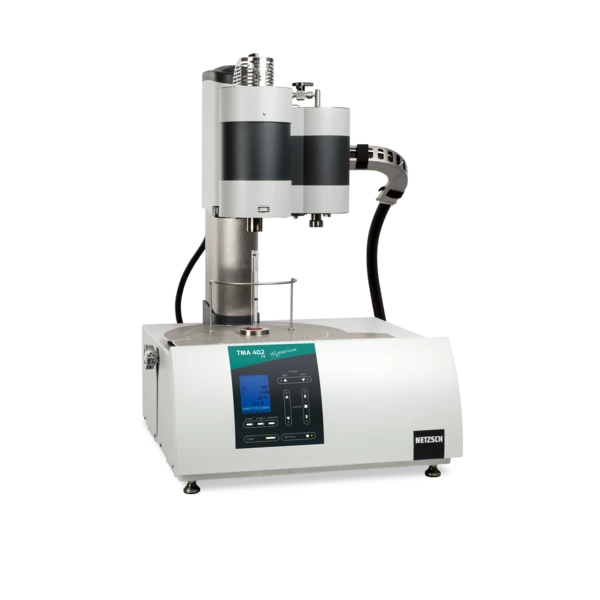
Force range
0.001 N to ± 4 N in steps of 0.2 mN
(F3 ± 3N)
Dig. resolution (force)
< 0.01 mN
Modulated force
Up to 1 Hz (only F1 )
Final vacuum pressure
< 10-4 mbar
Gas connections
Protective gas, 2 purge gases,
one independent purge gas
Temperature range
-150°C to 1550°C

